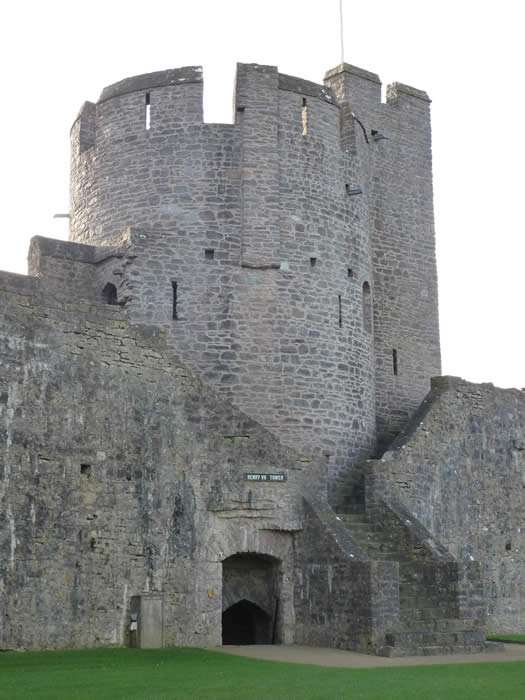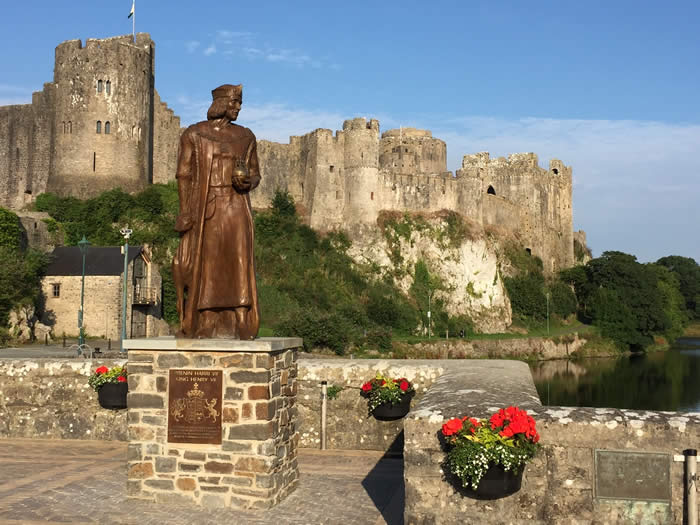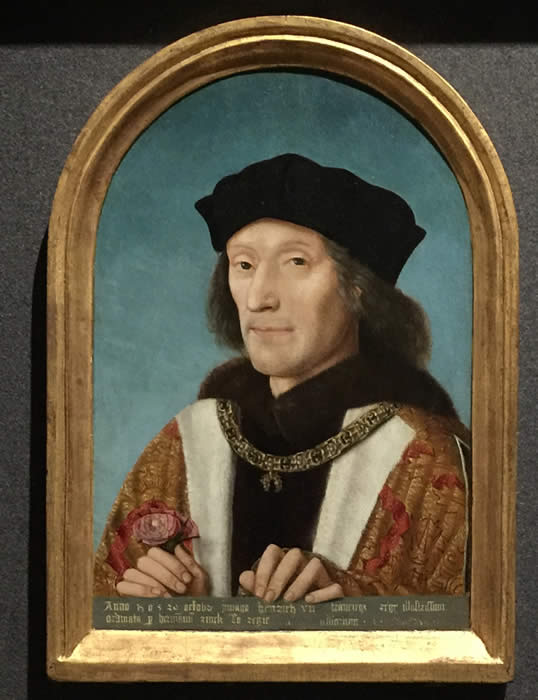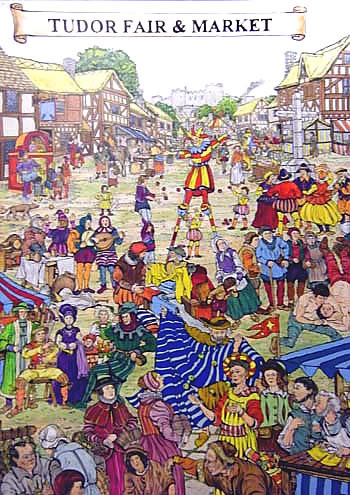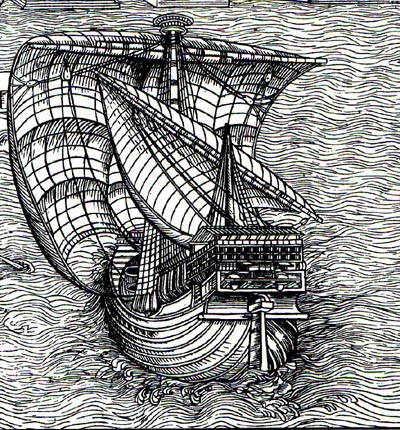
| HOME | ABOUT | PEMBROKE | MONKTON | TIMELINE | MUSEUM | LANDSCAPE | GALLERIES | PUBLICATIONS | CONTACTS |
Pembroke Story
THE TUDORS
HENRY TUDOR - PEMBROKE'S KING Pembroke has celebrated the fact that it is the birthplace of the Tudor dynasty by erecting a statue of Henry VII. The History Society led a prominent role in helping to bring this about, taking an active part in Pembroke Town Council's Regeneration Committee, organising events and fundraising intiatives. See Henry VII statue campaign Many Welshmen felt that Henry Tudor was the son of prophesy, the reincarnation of Owain Glyndwr, and that he would lead Wales to independence again. He never returned to Wales after becoming King, but he did appoint his son Henry ( later Henry VIII) Earl of Pembroke following the death of his uncle Jasper. Later, Henry made his ill fated wife Anne Boleyn Marchioness of Pembroke. Henry's great achievement was peace. During the Middle Ages, the Crown and Aristocracy fought each other for power and it was not until the 15th century when the Tudors came to power that the Crown reigned supreme. The 16th century saw many social changes including the reformation when Protestantism became the state religion and the dissolution of the monasteries when large areas of land ownership was transferred from the church to crown and aristocratic ownersip. Other important developments included the emergence of Parliament into a real political force and the beginning of modern government with an embryonic civil service. See also following page - Religious and Political Change
LIFE IN TUDOR PEMBROKE Ruinous and Decayed During the Tudor period much of the prosperity and prestige of Pembroke faded away. The 1543 Act of Union between England and Wales established Haverfordwest as a county in itself, and the result was that the new county and town became a centre of commerce. Pembroke was reduced to the status of a market town.
By the middle of the 16th century, there were only 52 households in St Michael’s parish, 81 in St Marys, with a further 66 in Monkton. The combined population of Pembroke and Monkton was probably not much more than 950 people, less than it had been at the height of the town’s prosperity in the medieval period.
In 1540, John Leland noted that ‘the east suburbe hath bene almost a great as the town, but now it is totally in ruine.’ George Owen, writing in 1542, described Pembroke as ‘very ruinous and much decayed, yet good for such houses as are standing’.
Many of the inhabitants depended on agriculture for their livelihood. There were a few merchants operating in the town and the customs house of the port of Milford was established on the quay beneath the castle. A fair was held in Main Street every 29 July and there was also a Saturday market. There were also several tanyards along the course of the stream that ran through what is now The Commons. A tucking mill, where cloth was dyed, washed and stretched, was situated near Kingsbridge. There was also a corn mill on the bridge near he North Gate and another possible one near the West Gate.
To the north of the Mill Pond was the Green, an area of common land, which supplied the inhabitants with fuel and winter fodder for their cattle.
Tudor Fair from the Pembroke Murals by George & Jeanne Lewis
Merchants and Captains Those who were involved in trade included local merchants, gentlemen, yeoman farmers and craftsmen. They often banded together to buy shares in small coastal vessels that were crewed by three or 4 men, Occasionally, the captains of these ships would also be amongst the most part they carried cargoes bought and paid for by others.
Some of the cargoes imported form the Continent went first to Bristol and were then shipped on in small coastal trading ships. Imports included oranges, lemons, spices, wax, salt, oil, cheese, linen, alum, pitch, butter, wine, canvas, marmalade, raisin, figs vinegar, sugar and soap. Exports consisted of coal, culm, wheat, barley, wool, fish and hides.
On 3 June 1566, a ship named the James of Milford arrived with a cargo of 4 yards of Irish cloth destined for John Commycke, a Pembroke merchant. Several weeks later, on 11 July, the Marie of Milford docked with a further cargo of 80 yards of Irish cloth, again for John Commycke. At the same time, Commycke was exporting culm and coal to Ireland.
Another notable Pembroke merchant was Morgan Powell of Pembroke, who dealt in a wide range of goods. On 6 February 1593, the Margaret Jonas arrived with a cargo which included 6 packs of linen and woollen cloth, barrels of oil, butter and soap, as well as iron, brass, lead, pewter, pitch, raisin, hops and starch.
In 1603, merchants trading from Pembroke were named as Morgan Powell, Richard Catchmaid, Peter and George Williams and William Rogers.
Pirates and Privateers By the 16th century, Milford Haven had become one of the most notorious areas in the kingdom for piracy. Thomas Phaer, a government official, described Milford as ‘the great resort and succour of all pirates and enemies in storms, whom the country cannot resist to lie at their pleasure.’
The long coastline of Pembrokeshire provided many hiding places for priate, whose prime targets were Spanish and French vessels carrying grain, fish , iron, salt, wines, spices, tropical fruits and ivory. In 1577, Robert Hicks, a notorious pirate, anchored off what is now Pembroke Dockyard whilst selling off coal and timber seized from the ship ‘Jonas’. Amongst the purchasers were a group of local merchants, including Morgan Powell of Pembroke.
In August 1577, the privateer Luke Ward captured a cargo of fish from a French ship and took it to Pembroke where it was ‘cried by the bellman and sold at the Quay’.
Local government officials were often part of the problem. George Clark, one of the local customs officers, ran a tavern at Angle which was a well-known haunt of pirates.
The Prize Ship On 28 January 1602, there was great excitement in Pembroke and in the other communities along the Milford Haven Waterway. Captain John Thomason had brought in the 250 ton Saint Espritt, a captured French vessel. Its cargo included calico, salt and oil, but the most valuable items were the spices it carried; cinnamon, cloves and pepper. The cinnamon was a particularly rich prize, valued at 3 shillings and 6 pence a pound. This may sound cheap by today’s standards, but in the Tudor period it amounted to a small fortune.
|
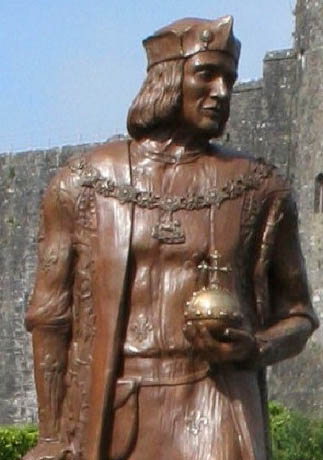 |
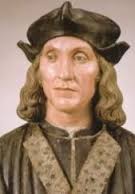 |
Through the Ages
 |
| Beginnings |
| Iron and Rome |
 |
| Dark Ages |
 |
| Normans |
 |
| Earldom of Pembroke |
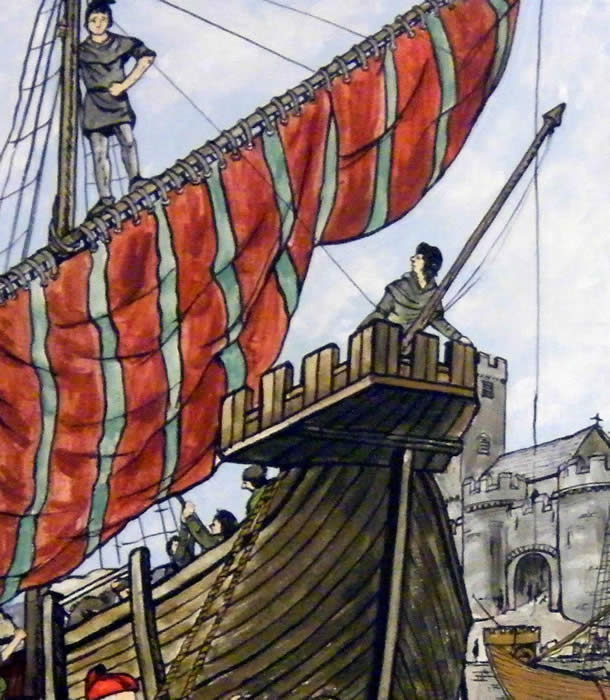 |
| Medieval Pembroke |
 |
| Wars of the Roses |
 |
| Tudor |
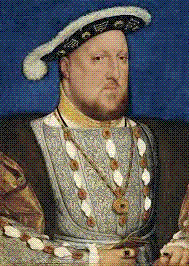 |
| Religious and political change |
 |
| Stuart & Civil War |
 |
| 18th Century |
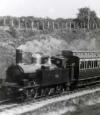 |
| 19th Century |
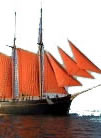 |
| Modern Times |
